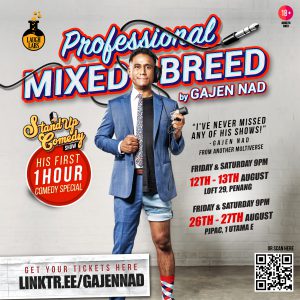How to buat lawak without offending anyone? We ask a ‘clean’ comedian.

- 82Shares
- Facebook56
- Twitter6
- LinkedIn6
- Email6
- WhatsApp8
You guys may already know about the Crackhouse Comedy Club incident that happened last month, right? Basically someone offended a lot of people at a comedy open mic event, and since then stand-up comedy sort of gained an unwholesome reputation. Before we go any further, those are two different things:
- open-mics, like the Crackhouse incident, allow literally anyone to go on stage and tell their jokes; and
- stand-ups are comedy events where the organizer decides who get to tell their jokes onstage.
So the main question here is, can safe, clean jokes still make people laugh, especially after that little incident? Two people think so, and they are actually planning a comedy show soon. Cilisos spoke to Gajen Nad, a ‘clean comic’, and Chi Ho, the founder of Laugh Labs Entertainment, the company that’s organizing that show.

And the first thing we asked was about sensitive jokes. Particularly…
How sensitive is too sensitive?

It’s hard not to offend anybody these days, so one might wonder: what counts as a sensitive joke? Gajen Nad says that it’s subjective, depending on the topic of the joke, the context and how well the audience takes it: a joke that is okay with one audience may not fly so well with another. Plus, it also depends on how you deliver it.
“When most people say no race jokes, what they mean is no racist jokes. Racist jokes means punching down on a certain race. Racial jokes can still be done in a smart and positive way, where it promotes diversity and inclusion. Same goes to gender jokes, it shouldn’t be punching down on a gender.” – Gajen Nad, to Cilisos.
Unfortunately though, as Chi Ho puts it, what’s offensive may not be so clear as some may even take offense with general topics, so it’s hard to draw the line.
“…there are people, a handful of them, who have complained about a few of my jokes so I don’t see the point of drawing lines if your intentions are clear. Some people just draw their own lines using a steamroller and a paintbrush.” – Chi Ho, to Cilisos.

Thankfully, both seem to agree that you don’t need to be controversial to get laughs. Gajen Nad built his career entirely on general topics (he made two jokes about his bank balance over the course of this interview), and Chi Ho attested that throughout his career, general topics actually brought the maximum amount of laughs.
“For any live performance, there’s trust between the performer and the audience where the bottom line is that the performer takes certain risks to achieve maximum entertainment. In comedy shows, that bottom line is laughter. Laughter is achieved when the performer and the audience are in an agreement.” – Chi Ho, to Cilisos.
The bottom line is, you don’t actually have to cross any lines to be funny. You just have to have good intentions, good punch lines, and know your audience. And speaking of that…
The audience also has a role to play in the success of comedy

If you guys didn’t know, the stand-up comedy scene has been in Malaysia for over a decade now, but it was recently trending in the public’s eye due to social media. According to Gajen Nad and Chi Ho, usually comedians would record their own shows and post them across their social media platforms. But sometimes, the audience might upload snippets of their own recordings online.
These snippets can be taken out of context, especially if you are not familiar with stand-up comedies. This wasn’t a problem back then…
“Based on my own observation, from when I started doing comedy back in 2006, only 1 percent of material might cause friction of this magnitude if, and this is a big if, those materials aren’t enjoyed as an act during a live show.” – Chi Ho, to Cilisos.
…but now, the chances of that happening is not so slim anymore. But social media isn’t necessarily a bad thing: Gajen Nad has quite the online presence, with over 2.9 million likes on TikTok, and the Internet allowed him to move his act online when the pandanemic hit.

Comedy is a two-way street, be it physically or virtually. As much as the comedian has a role to play (which is to make their audience happy), the audience also has a role to play – which is to sambut the comedian’s energy and not simply upload random snippets of an act online without context. If both sides are in harmony, then stand-up comedy will be able to continue brightening the lives of Malaysians.
“Stand-up comedy shows have been around for years, anyone from all walks of life can pay a fee, watch a show and leave after some laughs. … Trust in the vibrance of our nation and come watch a stand-up comedy show. We’ve got nothing to be worried about, I think.” – Chi Ho, to Cilisos.
So if by any chance you’re in Penang this weekend (Aug 12), catch Gajen Nad’s show, Professional Mixed Breed, to experience how comedy can be ‘clean’ and still be entertaining. Worry not if you’re in Kuala Lumpur – he’s coming here too!

And in case you’re wondering, no, he won’t be stripping.
“No (to stripping) for two reasons. I do not have a Top Gun Maverick body and I’ll be wearing a tailored made suit which is expensive.” – Gajen Nad, to Cilisos.
- 82Shares
- Facebook56
- Twitter6
- LinkedIn6
- Email6
- WhatsApp8
